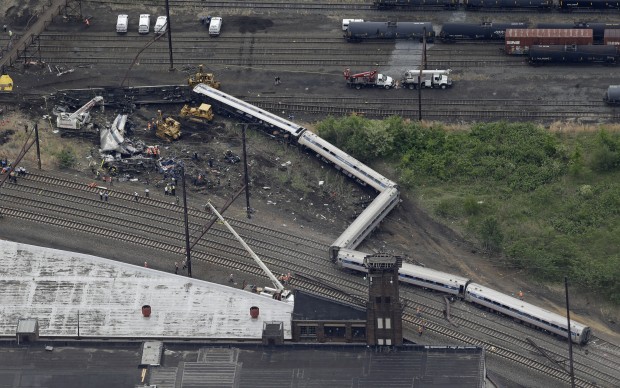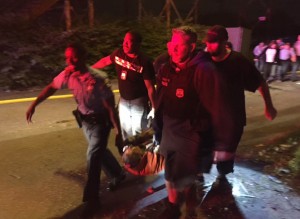What’s in those tank cars near the Amtrak derailment?
-
Susan Phillips

Patrick Semansky / AP
Emergency personnel work at the scene of a deadly train derailment, Wednesday, May 13, 2015, in Philadelphia with tank cars in the background. The Amtrak train, headed to New York City, derailed and crashed in Philadelphia on Tuesday night, killing at least six people and injuring dozens of others. (AP Photo/Patrick Semansky)
News footage of the Amtrak derailment in Philadelphia Tuesday night shows nearby tank cars that look similar to the rail cars carrying crude oil or other hazardous material across the country each day. In aerial photos, it looks as if the Amtrak train, traveling at 100 miles an hour, nearly missed creating an even greater catastrophe, if it had struck an oil train, say, or a train carrying chlorine gas. Residents quickly took to twitter, wondering about the content of those tank cars, and whether it was hazardous.
“This could be just one more in a litany of near misses,” said David Masur, director of PennEnvironment, an activist group working to ban oil trains.
Conrail spokesman John Enright confirmed on Thursday that the nearby tanker cars did not contain flammable crude oil or ethanol. But he wouldn’t say what was in those cars, only that some cars in the yard were empty, and others weren’t.
But it wouldn’t be far-fetched for a passenger rail car to collide with an oil train, dozens of oil trains run through the state on their way to Philadelphia and South Jersey refineries each week. In fact, Norfolk Southern runs oil trains on a track that crosses above Amtrak lines, close to the derailment. Bakken crude oil from North Dakota crosses those lines daily, traveling across the Delaware river, and down to refineries in South Jersey. WHYY reporter Tom MacDonald says he saw the black tankers about 50 yards from the derailed Amtrak train. Oil trains frequently run parallel to commuter rail lines throughout the city.
But it’s still unclear what is in those tank cars sitting near the Amtrak crash site.
Below is a video of an oil train running parallel to a Center City bound SEPTA train on the West Trenton line, during a morning commute from the Langhorne Station. (Eugene Sonn, WHYY)
“It could be corn oil, it could be very benign stuff,” Conrail spokesman John Enright told StateImpact on Wednesday.
The accident occurred on Amtrak’s rail lines, but the scene is very close to a Conrail yard, which Enright says is used for local transport.
“I know the sensitivity to the whole crude oil situation,” said Enright. “One shouldn’t presume anything.”
Enright says Conrail knows what’s in the cars on their tracks but considers it proprietary information, not to be revealed unless there’s an emergency.
“If there was an incident then that information would be readily available to [first responders],” he said.
In this case, the Amtrak train did not hit any nearby freight cars, so the contents of the black tankers remains a mystery.
Norfolk Southern, which operates the oil trains that cross the Amtrak line, did not respond to requests for comment. And the American Association of Railroads would also not comment on the freight rail traffic in the area. Philadelphia’s Office of Emergency Management would not comment on the contents, saying they were focusing on the accident itself. The National Transportation Safety Board referred questions to the Federal Railroad Administration. But the FRA did not respond to questions. And a spokesman for Philadelphia Mayor Michael Nutter said he didn’t know what is in the nearby rail cars.
But rail safety experts say the accident could have been much worse if the Amtrak train did hit those black tank cars, and if those cars were carrying explosive or flammable material.

Paul Cheung / AP Photo
A passenger is carried following an Amtrak train crash Tuesday, May 12, 2015, in Philadelphia. Train 188 was traveling from Washington to New York City. (AP Photo/Paul Cheung)
Fred Millar is an independent rail safety expert.
“Having the oil train sitting there is not necessarily an undangerous situation,” said Millar.
Millar says, although it’s rare, trains have been known to run into each other. Federal investigators recently released a report about an oil train explosion in North Dakota in 2013, where the train hit a derailed freight train.
“One kind of industrial accident can set off another,” he said.
Not only would the death toll be higher, but the neighborhood would need to be evacuated.
Jim Blaze is an economist and railroad consultant who worked in the railroad industry for 30 years.
“Let’s say there was [hazardous material] in those rail cars,” said Blaze. “If the cars cracked open, it could have been an explosive force and caused a chain reaction. What would the casualty rate have been as a result? Could you imagine evacuating 750,000 people? What’s that going to cost? What’s the lost business revenue?”
Not only is it unclear what’s in those nearby tank cars. It’s unclear if Philadelphia’s first responders would be ready. The city’s Office of Emergency Management says it’s done exercises to prepare. But it’s not clear if the exercise has included passenger rail cars.
Pennsylvania’s Emergency Management Agency spokesman Cory Angell says that’s not a scenario he’s heard discussed.
Delaware County’s Office of Emergency Management says the risk of an Amtrak or regional rail line hitting an oil train while traveling through Delco is low because the passenger rail cars don’t run in close proximity to the oil trains, as they do in Philadelphia. Ed Truitt runs Delaware County’s OEM.
“We’ve looked at a lot of different scenarios and that was never conceived as being a threat in Delaware County,” said Truitt.
Truitt says the rail cars only travel between midnight and 5 AM through the county.
Meanwhile, the American Petroleum Institute filed a lawsuit on Tuesday to block the implementation of new oil train safety rules. On Thursday environmental groups also filed suit.
*This post has been updated with more information from Conrail.
















